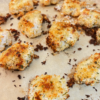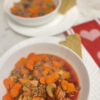Have you ever heard of histamine intolerance?
It’s something I work very closely with in my private practice! When working with clients who present classic symptoms of histamine overload, I have seen great success when implementing a low-histamine diet or limiting specific high histamine foods.
What is Histamine?
Histamine is a chemical involved in our immune system, digestion, and central nervous system. It communicates important messages from our body to our brain and is also a component of stomach acid, which helps us break down food. Histamine’s role in the body is to cause an immediate inflammatory response. It serves as a red flag in your immune system, notifying your body of any potential attackers. For example, have you ever suffered from seasonal allergies, and as soon as you take your medicine you feel fresh as new? Those are usually antihistamines, which are changing your histamine response (blocking your sensation of the histamines). Enzymes will typically break down histamine so that it doesn’t get overly high, but if we don’t break down histamine properly, it builds up and you develop histamine intolerance. Histamine travels throughout the bloodstream and can affect your gut, lungs, skin, brain, and entire cardiovascular system. There are a variety of histamine intolerance symptoms, but the typical ones include the following –
- Headaches/Migraines
- Nasal Congestion or Sinus Issues
- Fatigue
- Hives
- Digestive issues
- Irregular Menstrual Cycle
- Nausea
- Vomiting
- Abdominal Cramping
- Tissue Swelling
- Anxiety
- Difficulty Regulating Body Temperature
- Dizziness
What Can Cause Histamine Intolerance?
This question can vary depending on the person but some common causes include allergies (IgE reactions), bacterial overgrowth (SIBO), leaky gut, GI bleeding, Diamine Oxidase (DAO) deficiency (the enzyme that breaks down histamine), and histamine-rich foods. As a RD, limiting or removing high histamine foods has worked wonders for some clients who are suffering from these conditions. High histamine foods include –
- Fermented alcoholic beverages ( like wine, champagne and beer)
- Fermented foods (sauerkraut, vinegar, soy sauce, kefir, yogurt, kombucha)
- Vinegar-containing foods (pickles, mayonnaise, olives)
- Cured meats (bacon, salami, pepperoni, luncheon meats and hot dogs)
- Soured foods (sour cream, sour milk, buttermilk, soured bread)
- Dried fruit (apricots, prunes, dates, figs, raisins)
- Most citrus fruits
- Aged cheese including goat cheese
- Nuts (walnuts, cashews, and peanuts)
- Vegetables (avocados, eggplant, spinach, and tomatoes)
- Smoked fish and certain species of fish (mackerel, mahi-mahi, tuna, anchovies, sardines)
Additionally, there are specific foods that are known to trigger histamine release into the body, and those foods include:
- Alcohol
- Bananas
- Chocolate
- Cow’s Milk
- Nuts
- Papaya
- Pineapple
- Shellfish
- Strawberries
- Tomatoes
- Wheat Germ
- Many artificial preservatives and dyes
If you think you might have a histamine intolerance, there are a few steps you can take! One option is to try elimination & reintroduction of these foods. Remove high histamine foods for about 2-4 weeks and reintroduce them one by one to see if you ignite any type of reaction. Another option is have your doctor take a blood test to see what your DAO levels are (remember – the enzymes that help breakdown histamine). A high ratio of histamine to DAO illustrates that you are ingesting too much histamine and that you don’t have enough DAO to break it down. If this is the case, there is supplementation that can help!
This can seem like a lot and a bit overwhelming, I know. I work with my patients every step of the way to make this transition as easy and attainable as possible, in hopes of decreasing or eliminating their symptoms. A low histamine diet can be challenging at first when trying to remember all of the foods to limit and adjust how you’re prepping and cooking your meals. If you’re new to a low-histamine diet and are trying to give it a go, I’ve included a general 7-day meal plan below outlining what some breakfast, lunch, snack, and dinner options might look like.
If you think you may have a histamine intolerance or are currently experiencing any of these symptoms, reach out and let’s have a chat!








